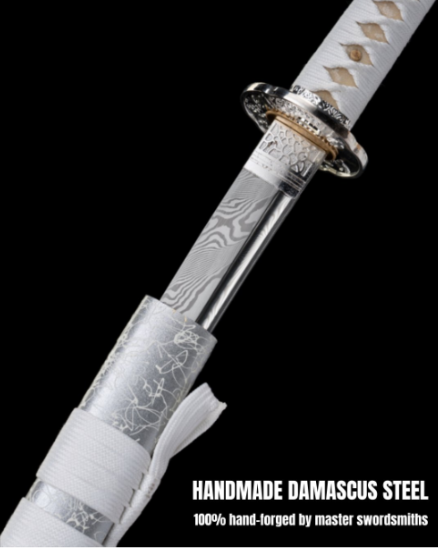The katana is one of history’s most iconic blades – its curved shape instantly recognizable across cultures – yet there’s still a lot of confusion about whether ‘katana’ and ‘samurai sword’ are just interchangeable terms. But if you scratch beneath the surface, the difference between these two terms reveals itself in Japan’s rich warrior history and the evolution of its deadly fighting tools.
This article sorts out the connection between katanas and samurai swords by looking at their roots in Japan’s martial past, their unique characteristics & roles in feudal Japan. You’ll see that every katana is a samurai sword, but not every samurai sword is a katana.
The Early Days of Japanese Sword-Making
Japanese sword-making started some 300-538 CE with straight-bladed swords that came over from mainland Asia. As the military needs of Japan changed over centuries of fighting, skilled swords had to adapt their techniques to create better tools for battle, both on horseback and on foot.
Things really took off in the Heian period (794-1185 CE) when Japanese metallurgists made a major breakthrough. They discovered that by curving the blade while hardening it – in other words, applying a layer of clay to create different hardness levels across the steel – they got a better cutting edge and a lot less breakage. This discovery set the stage for what would become the katana’s defining shape.
By the Kamakura period (1185-1333 CE), the samurai had got themselves established as the powerful force they were meant to be. These horseback warriors needed a weapon that combined reach, sharpness and draw speed – and this is when swordsmiths perfected the tachi, a sword worn edge-down from the belt. It was a precursor to the katana and reflected the changing combat styles as warfare moved from horses to foot soldiers.
What Makes a Katana?
The katana is the ultimate expression of Japanese sword-making and its signature shape is actually a set of specific features that make it stand out from the rest. A katana’s roughly 60-80 cm curved single-edged longsword with the handle and tang adds up to about a metre in total length.
The key structural characteristics that set the katana apart include:
- Curvature (sori): A nice smooth arc that runs from the tang to the tip – perfect for using a draw-cutting technique
- Single-edged blade: Sharp on one side with a reinforcement to give it strength
- Differential hardening: Creates that distinctive hamon (temper line) where the hard cutting edge meets the flexible spine
- Full tang: The blade goes right through the handle & is held in with bamboo pegs
Building one is an incredible skill that requires patience and skill. You start by getting the right steel – the sort that’s been produced in traditional clay kilns to give you the perfect carbon content for a blade – and then you fold, heat & hammer it to get the layered structure that’s what makes Japanese swords so strong.
Heat treatment is the really critical bit – it’s when you apply this stuff of varying thickness all over the blade, heat it to a precise temperature & then quench it in water to get that delicate balance of sharp edge & shock-resistant flexibility. It’s the bit that stops the blade shattering in battle and keeps it cutting properly.
Polishing is an age-old art that takes weeks of meticulous work with finer & finer stones. It’s not just sharpening the blade – it’s bringing out the grain patterns, the crystalline structure and that amazing hamon pattern that proves the blade’s been made by a real master.
The Bigger Picture of Samurai Swords

Samurai swords cover all the blades used by Japan’s fighting class over the centuries. They’re a broader category than just katanas, and while the katana is the king of samurai swords, they used loads of other blades for different jobs.
The daisho combo was the mainstay of samurai gear in the Edo period (1603-1868). It consisted of:
- Katana: The one you’re most likely to know – the main blade, worn edge-up through the belt for quick-draws
- Wakizashi: A smaller companion blade (30-60 cm blade length) that was used for indoor fighting, backup defense & even the formal way of seppuku
In addition to these two, samurai used other specialized blades:
Tanto – small daggers that were great for close quarters fighting & serving as utility tools – and they were so short, about under 30cm. Even though they’re small, they’re perfect for tight spaces where a longer blade would be unwieldy.
Tachi – the sword that predated the katana & was the samurai’s main mounted weapon. These were edge-down from belt hangers, were longer (often over 80cm) & were just devastating from horseback. Many of the surviving tachi blades were later shortened & mounted as katanas – that process is called suriage.Nodachi and ōdachi : the behemoth battlefield swords that were truly a sight to behold, with some monstrous examples stretching blade length over 90 centimeters. You need serious strength to wield these things – and even then, they were more of a “use as last resort” sort of tool for taking down cavalry, or more often, a symbol of the owner’s status and prestige.
Each blade type, from the nodachi to the katana, was a perfect reflection of what the samurai needed to survive on the battlefield, their own social standing, and the ever-changing nature of Japanese warfare. And what that shows us is that while the katana may be the iconic samurai sword, it’s far from the only game in town – in fact, the samurai’s arsenal was a complex and adaptable system, designed to take on all sorts of different combat situations.
Getting to the Heart of the Katana as a Samurai Sword
Think of the relationship between katanas and samurai swords like squares and rectangles. You know, a square is basically a rectangle, but not every rectangle has to be a square. Same with katanas and samurai swords – every katana is a samurai sword, but the term “samurai sword” runs way beyond just katanas – it includes all sorts of other blade types too.
The katana earned its status as the ultimate symbol of the samurai class – but it’s worth noting that all that iconic status came after a whole lot of other blades had been doing the job just fine for a long time







